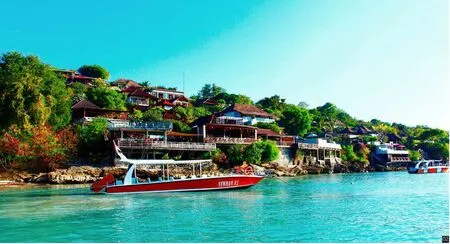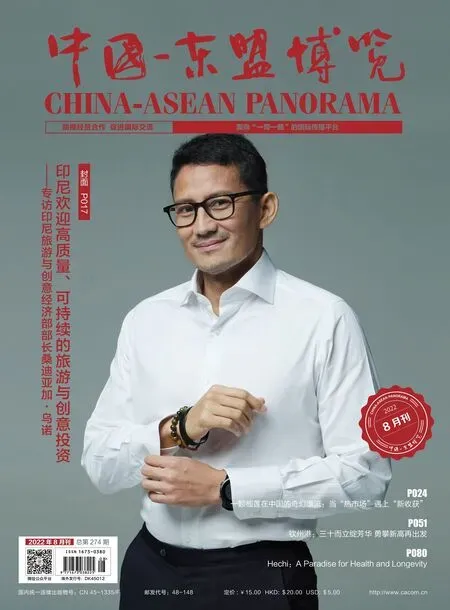Indonesia Welcomes High-quality and Sustainable Investment in Tourism and Creative Economy— An Exclusive Interview With H.E. Sandiaga Uno, Minister of Tourism and Creative Economy of Indonesia
Written by Han Xuya, Prima Surbakti, and Anastasya Gabriella, Reporters of the Magazine in Indonesia
Brief Introduction of Sandiaga Uno:
Sandiaga Uno, born in Indonesia’s Riau Province on June 28, 1969, is an Indonesian entrepreneur, investor, politician, and important leader in the Greater Indonesia Movement Party. He is currently the Minister of Tourism and Creative Economy of Indonesia. In 1986, he received the Chevron Scholarship and studied at Wichita State University in Kansas,USA. In 1990, he received a bachelor degree in business administration.After returning to Indonesia, he worked for Bank Summa. Afterwards,he went to the United States for further study with Chevron Scholarship again and obtained a master degree in business administration from George Washington University in 1992. After graduation, he successively served as the Investment Manager of Singapore Seapower Asia Investment Co.,Ltd. (Seapower Asia Investment), the Investment Manager of MP Group Co., Ltd., and the Vice Executive Chairman of Canada NTI Resources.After the 1997 Asian financial crisis, he chose to return to Indonesia to start a business and started his entrepreneurial career. In 1997, he founded Recapital Advisors with his middle school classmate Rossan Ruslani, and in 1998, he and Edwin Soeryadjaya founded Saratoga Investama Sedaya which went public in 2013. From 2005 to 2011, Sandiaga served as the President of the Indonesian Young Entrepreneurs Association. During this period, he also served as the Chairman of the Standing Committee of the Small and Medium Enterprises Association of the Indonesian Chamber of Commerce and Industry. From 2011 to 2013, Sandiaga ranked among the top 40 richest people in Indonesia byForbes.
In 2015, he abandoned business and pursued politics and served as the Vice Chairman of the Supervisory Board of the Greater Indonesia Movement Party. In 2017, he partnered with Anies to win the election for the Deputy Governor of Jakarta. On October 16 of that year, he became the Deputy Governor of Jakarta. In August 2018, it was announced that he would partner with Prabowo to participate in the Indonesian presidential and vice-presidential election, and the result ended in defeat with 44.5% of the votes against the incumbent President Joko Widodo and Ma’aruf Amin. At the end of 2020, Sandiaga was nominated by Joko Widodo to become the Minister of Tourism and Creative Economy of Indonesia.
I n recent years, China-Indonesia relations have achieved rapid development. Cooperation between the two countries in cultural creativity, artistic exchanges, tourism cooperation, and personnel exchanges showed many highlights, receiving positive social responses. However, since the outbreak of the 2020 COVID-19 pandemic, global economy, transportation,and tourism have been hit hard as never before, which also had a severe impact on the exchanges and tourism cooperation between China and Indonesia. Under such a severe situation, what are the highlights of bilateral exchanges and cooperation? As the largest economy in ASEAN, what measures will Indonesia take to stimulate its tourism? Reporters of theChina-ASEAN PanoramaMagazine in Indonesia had an exclusive interview with H.E. Mr. Sandiaga Uno, Minister of Tourism and Creative Economy of Indonesia, on the issues mentioned.
CHINA-ASEAN PANORAMA:In recent years, Indonesia and China have achieved remarkable results in tourism cooperation. For example, Indonesia’s Bali is wellknown to Chinese people and attracts many Chinese tourists. Could you please tell us what did the Ministry of Tourism and Creative Economy do to promote tourism cooperation between Indonesia and China?
Sandiaga Uno:Cooperative relationship between Indonesia and China has continued to improve in the past two years, especially before the COVID-19 pandemic.We continue to strengthen bilateral cooperation by attracting Chinese tourists. During the COVID-19 pandemic, we collaborated to deal with the impact of the pandemic on the tourism sector, including conducting joint pandemic prevention and control to guide the tourists from both sides, providing oxygen supplies, and helping sectors that were heavily affected by the pandemic to restore. After the pandemic and China’s reopen of borders, we hope the tourist visits from China and other countries could remain high. According to the Central Statistics Agency of Indonesia,foreign tourist visits to Indonesia through the port of entry in March 2022 reached 40,790,among which Chinese tourist visits were 4,831,accounting for 11.84%. In addition, Indonesia held a series of tourism promotion activities in Shanghai, Hong Kong, and other cities in China, including exhibitions, brand promotion events, market sales, tourism festivals, etc.,to build the “Wonderful Indonesia” brand,aiming to make tourist destinations in Indonesia known to the world including China.
Meanwhile, we participated in the China International Travel Fair, held promotion activities in some Chinese cities, provided regular charter services for Chinese tourists who travel to Indonesia, and opened new routes from Chinese cities to Indonesian cities other than Bali and Jakarta. We also held a Familiarization Trip, invited media and travel agencies to attend, and sold Indonesian travel packages through online travel agencies and wholesalers.
CHINA-ASEAN PANORAMA:The COVID-19 pandemic has greatly damaged global tourism.Could you please tell us what changes has the pandemic brought to Indonesia’s tourism?Under the pandemic, what did Indonesia do to ensure a stable domestic and foreign tourism market?
Sandiaga Uno:Yes, The pandemic hit the tourism sector and the creative economy greatly. The international tourism turnover in 2020 was US$ 3.54 billion, down 79.1%compared with 2019’s 17 billion dollars. In more than two years affected by the pandemic,many workers in the tourism sector were laid off. Two million tourism practitioners in Indonesia lost their jobs. To ensure that the domestic and international tourism markets remain stable, we carried out some mitigation programs to reduce the difficulties encountered by tourism practitioners who were affected the most by the pandemic,and encouraged them to bounce back and reemploy. We focused on promoting domestic tourism because it is one of the main pillars in the pandemic. In addition, we called on domestic people who travel abroad every year to choose Indonesia as their destination. They have the potential to generate Rp 150 trillion(nearly 60 billion yuan) annually, which can be a temporary substitute for foreign tourists.
CHINA-ASEAN PANORAMA:Currently, some ASEAN countries have announced the reopen of borders to stimulate tourism recovery. As the pandemic slowly becomes controllable,what will Indonesia do next to accelerate its tourism recovery?
Sandiaga Uno:We will provide convenience for international tourists and make sure their entry to Indonesia is easy. Measures to achieve the goal include exempting tourists from quarantine and PCR test when entering Indonesia, providing Visa on Arrival (VOA)and expanding it to 60 countries, increasing international flights, and reopening flight routes to Indonesia, especially to major tourist destinations such as Bali which are in great demand by tourists. Now, we have canceled PCR test regulations and resumed VOA.Currently, there are 17 airlines serving 17 international routes including the one from China to Bali.
CHINA-ASEAN PANORAMA:On January 1,2022, RCEP officially entered into force.Indonesia is also working on ratifying this trade pact that facilitates the movement of people among the member countries. In your opinion, what opportunities would RCEP bring to the China-Indonesia tourism cooperation? What measures should China and Indonesia take to promote the development of tourism?
Sandiaga Uno:This is a new action to attract quality and sustainable tourists.We offer five super-priority destinations to Chinese investors, namely Lake Toba in North Sumatra, Borobudur in Jawa Tengah’s Magelang, Mandalika in West Nusa Tenggara Barat, and Labuan Bajo and Kupang in East Nusa Tenggara Barat. From the perspective of creative economy, mobile apps, food, and energy sector can create lots of jobs. Moreover,investment potential also exists in special economic zones such as Tanjung Lesung,Pandeglang, Mandalika, Central Lombok, Tanjung Kelayang, Belitung, Morotai,Morotai islands, Singosari-Malang, Likupang, North Minahasa, Lido, Bogor, and Batam. The concept of the special economic zone of Indonesia resembles that of China’s Shenzhen and Shantou, which is to promote the economic development of a city through implementing special economic policies. We want to attract investment from China and are now promoting the put-into-use of more direct flights from Chinese cities to the main destinations in Indonesia.
All in all, Indonesia’s tourism and creative economy departments are now focusing not on quantity but on quality and sustainability. It’s also the direction for us to work on to improve the quality of tourism in Indonesia.

01 /Lake Toba in North Sumatra

02 /Bali, Indonesia
CHINA-ASEAN PANORAMA:That’s all for the interview. We sincerely hope that Your Excellency will have the opportunity to come to and travel Guangxi in the future as soon as possible. Thank you.
Sandiaga Uno:Yes, of course. I also really hope to have the opportunity to come to Guangxi to travel. Thank you for your invitation.

